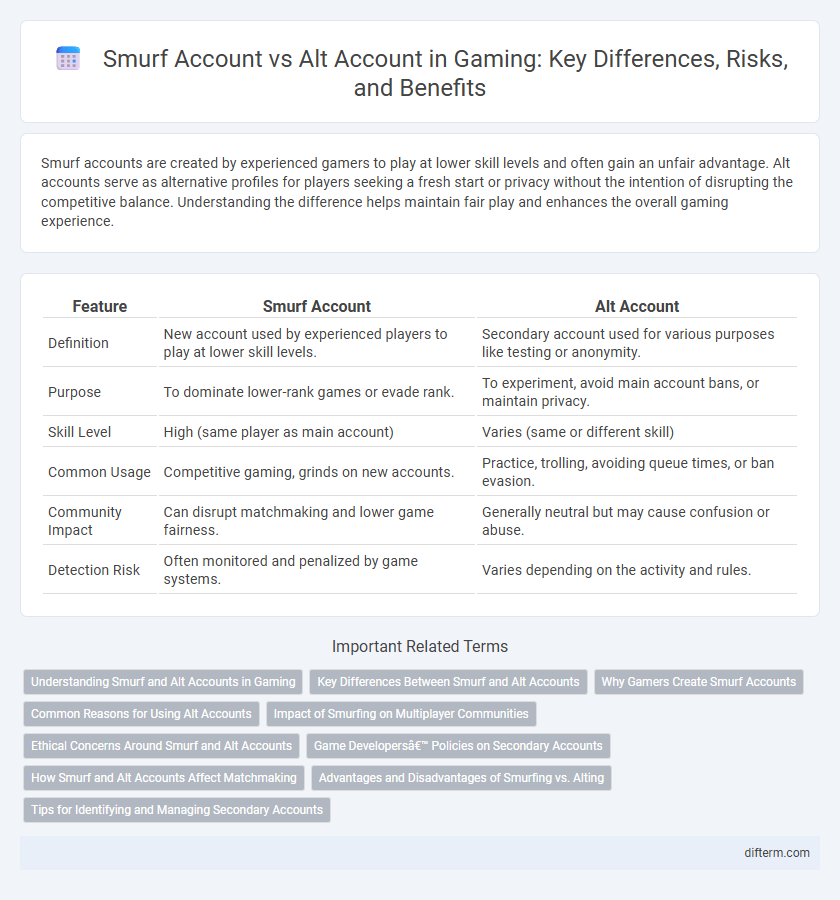Smurf accounts are created by experienced gamers to play at lower skill levels and often gain an unfair advantage. Alt accounts serve as alternative profiles for players seeking a fresh start or privacy without the intention of disrupting the competitive balance. Understanding the difference helps maintain fair play and enhances the overall gaming experience.
Table of Comparison
| Feature | Smurf Account | Alt Account |
|---|---|---|
| Definition | New account used by experienced players to play at lower skill levels. | Secondary account used for various purposes like testing or anonymity. |
| Purpose | To dominate lower-rank games or evade rank. | To experiment, avoid main account bans, or maintain privacy. |
| Skill Level | High (same player as main account) | Varies (same or different skill) |
| Common Usage | Competitive gaming, grinds on new accounts. | Practice, trolling, avoiding queue times, or ban evasion. |
| Community Impact | Can disrupt matchmaking and lower game fairness. | Generally neutral but may cause confusion or abuse. |
| Detection Risk | Often monitored and penalized by game systems. | Varies depending on the activity and rules. |
Understanding Smurf and Alt Accounts in Gaming
Smurf accounts in gaming are secondary accounts created by experienced players to compete against less skilled opponents, often impacting the matchmaking balance. Alt accounts serve as alternative profiles used for various purposes, including experimenting with different playstyles or maintaining anonymity without necessarily exploiting skill gaps. Recognizing the differences between smurf and alt accounts helps in addressing game integrity and fair competition issues within online multiplayer environments.
Key Differences Between Smurf and Alt Accounts
Smurf accounts are primarily created by experienced players to play at lower skill levels or for anonymity, often impacting game balance and matchmaking, while alt accounts serve various purposes such as practicing new strategies, avoiding bans, or separating different play styles without necessarily intent to deceive. Smurfs typically exhibit skilled gameplay inconsistent with their apparent rank, causing frustration among regular players, whereas alt accounts often maintain consistent skill representation aligned with the player's true ability. Understanding these distinctions helps in addressing issues related to competitive integrity and player experience in online gaming communities.
Why Gamers Create Smurf Accounts
Gamers create smurf accounts primarily to experience gameplay at lower skill levels, allowing them to dominate matches more easily and enjoy a sense of superiority. These accounts also provide a way to practice new strategies or characters without affecting their main account's ranking or statistics. Additionally, smurfing helps players avoid long matchmaking queues found at higher ranks by entering games with less competitive opponents.
Common Reasons for Using Alt Accounts
Gamers often create alt accounts to practice new strategies or improve skills without affecting their main account's ranking or reputation. Alt accounts provide a platform for experimenting with different characters or roles, allowing players to refine gameplay in a low-pressure environment. These accounts also serve as a backup to avoid losing progress or experience due to bans, technical issues, or other disruptions.
Impact of Smurfing on Multiplayer Communities
Smurf accounts in gaming, where experienced players use secondary accounts to play against less skilled opponents, disrupt matchmaking balance and degrade the multiplayer experience. This practice leads to frustration, toxic behavior, and player retention issues, as newcomers face unfair competition. Smurfing undermines fair play, diminishing the overall health and growth of multiplayer communities.
Ethical Concerns Around Smurf and Alt Accounts
Smurf accounts, often created by experienced gamers to play against less skilled opponents, raise significant ethical concerns including unfair matchmaking and disruption of competitive balance. Alt accounts, used for multiple purposes such as practicing or avoiding bans, also pose challenges related to account integrity and community trust. Both practices undermine fair play principles and can lead to negative impacts on player experience and game reputation.
Game Developers’ Policies on Secondary Accounts
Game developers often differentiate between smurf accounts and alt accounts through their policies, with smurfing frequently prohibited due to its impact on matchmaking and gameplay fairness. Alt accounts, while sometimes allowed for legitimate reasons like testing or role-playing, must comply with terms of service to prevent abuse or fraud. Enforcement measures include account suspension, matchmaking penalties, and in some cases, IP bans to maintain balanced gaming environments.
How Smurf and Alt Accounts Affect Matchmaking
Smurf accounts, typically high-skill players using low-ranked profiles, create unbalanced matchmaking by dominating less experienced opponents, which disrupts fair competition and elongates matchmaking times. Alt accounts, often used for experimenting with new strategies or maintaining anonymity, can also skew matchmaking metrics by introducing inconsistent skill estimates within the player pool. Both account types contribute to inflated rank disparities and reduce overall matchmaking quality, impacting player satisfaction and game retention.
Advantages and Disadvantages of Smurfing vs. Alting
Smurf accounts offer advantages like easier matches and faster progression by playing at lower skill levels but carry risks such as account bans and negative community impact. Alt accounts provide flexibility for trying new roles or strategies without affecting the main account's rank but may lack the challenge or thrill of smurfing. Both smurfing and alting affect competitive integrity differently, with smurfing often criticized for unfair advantages, while alts are seen as more acceptable for personal experimentation.
Tips for Identifying and Managing Secondary Accounts
Smurf accounts often feature high-skill players using low-rank profiles to gain competitive advantages, while alt accounts may serve various purposes such as experimenting with new strategies or maintaining anonymity. Identifying smurf accounts involves analyzing unusual skill level disparities, inconsistent gameplay patterns, and rapid ranking changes, while managing secondary accounts effectively requires clear usage intentions and adherence to game policies to avoid penalties. Monitoring account behavior with tools like third-party stat trackers and fostering community reports can also assist in distinguishing smurfing from legitimate secondary account use.
Smurf Account vs Alt Account Infographic

 difterm.com
difterm.com